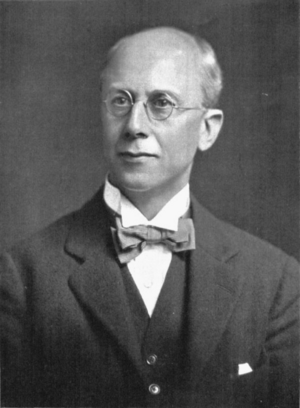Frank Twyman facts for kids
Quick facts for kids
Frank Twyman
FRS FInstP
|
|
|---|---|

Twyman in 1929
|
|
| Born | 17 November 1876 Canterbury, Kent, England
|
| Died | 6 March 1959 (aged 82) St Pancras, London, England
|
| Education |
|
| Occupation | Designer of optical instruments |
| Spouse(s) |
Phillipine Katherine Elisabeth Hilger
(m. 1906) |
| Children | 4 |
| Engineering career | |
| Discipline | Optical engineering |
| Employer(s) |
|
| Significant design | Twyman–Green interferometer |
| Awards |
|
Frank Twyman (17 November 1876 – 6 March 1959) was a brilliant British engineer. He was famous for designing special tools called optical instruments. These tools use light to help us see things better or measure them. He also helped create an important device called the Twyman–Green interferometer.
Contents
Early Life and Education
Frank Twyman was born in Canterbury, Kent, England. This was on November 17, 1876. He was one of nine children in his family. His father, George Edmund Twyman, was a ropemaker.
Frank went to Simon Langton School first. After that, he studied electrical engineering. He attended Finsbury Technical College. Later, he earned a special scholarship. This allowed him to study at Central Technical College in London. By 1897, he had already written his first science paper.
A Career in Optics
Frank Twyman started his career testing telephone cables. He worked for the Fowler Waring Cables Company for a short time. In 1898, he joined Adam Hilger. This company made optical instruments. He began as an assistant to Otto Hilger.
After Otto Hilger passed away, Frank Twyman became the managing director. He led the company until 1946. Then he became the chairman.
Designing New Instruments
Until 1910, Frank Twyman was in charge of designing new equipment. He helped create a special spectrometer. This tool measures light and its different colors. He also made a spectrograph. This device records light patterns.
These tools were special because they used quartz. Quartz allowed them to see ultraviolet light. Regular glass would block this type of light.
The Twyman–Green Interferometer
Between 1918 and 1923, Frank Twyman worked with Alfred Green. They developed the Twyman–Green interferometer. This device was based on an older invention. It was mainly used to test optical equipment. It helped make sure lenses and mirrors were perfect.
Awards and Recognition
Frank Twyman's work was highly respected. In 1924, he became a member of the Royal Society. This is a very old and famous science group.
In 1926, he received two important awards. He won the Duddell Medal from the Physical Society. He also got the John Price Wetherill Medal from the Franklin Institute. In 1956, he won the Gold medal from the Society for Applied Spectroscopy.
He also gave advice to another company, E. R. Watts and Son. In 1948, this company joined with Adam Hilger Ltd. They formed a new company called Hilger & Watts Ltd. Frank Twyman continued to advise them until he passed away.
Personal Life
In 1906, Frank Twyman married Phillipine Katherine Elisabeth Hilger. She was the daughter of Otto Hilger, his former boss. They had four children together.
Frank Twyman also enjoyed writing. In 1956, he wrote a book about his family's history. He also wrote about his ideas on economics. Another book he wrote was about apprenticeships.
Frank Twyman died at his home in St Pancras, London. This was on March 6, 1959.

